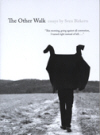The Other Walk
We’re walking. We’re walking. Like “those colored paddles and banners (the new tourist universal)” that tour guides wield to direct their charges’ attention, Sven Birkerts holds up a metaphorical banner to keep us following along. When he wanders, it is not without direction. Invoking Robert Frost’s diverging road: “This morning, going against all convention, I turned right instead of left and took my circuit…in reverse.” The author, one of the country’s foremost literary critics and editor of the literary journal AGNI, links walking with thought: “There is the rhythm, the physics, of walking, the drumbeat of repetition, stride, stride, stride, and then there is the fugue of the walking mind, laid over it, always different, always tied in some way to the panning of the gaze and the eye’s quirky meandering.”
We’re walking. We’re walking. Like “those colored paddles and banners (the new tourist universal)” that tour guides wield to direct their charges’ attention, Sven Birkerts holds up a metaphorical banner to keep us following along. When he wanders, it is not without direction. Invoking Robert Frost’s diverging road: “This morning, going against all convention, I turned right instead of left and took my circuit…in reverse.” The author, one of the country’s foremost literary critics and editor of the literary journal AGNI, links walking with thought: “There is the rhythm, the physics, of walking, the drumbeat of repetition, stride, stride, stride, and then there is the fugue of the walking mind, laid over it, always different, always tied in some way to the panning of the gaze and the eye’s quirky meandering.”
The Other Walk comprises 45 short pieces, most in the two- to three-page range, and with each, Birkerts considers his route with a keen eye, wit, and spare, elegant prose: “the pebbled path, that carefully landscaped philosopher’s walk. …it was a metaphysical circuit: once around felt like the distance of a deep thought; twice and you could begin to get somewhere.”
Many of the pieces include a literal walk, but in most, the passage is sentimental, nostalgic: “I’m not simply looking at the photos, I’m also looking through something—like distance, like time—it’s a clear layer. Then and now. I can almost pinch the difference between my thumb and forefinger.”
Besides old photos, chess pieces, tin cups, lighters, ladders, coils of rope, stone shards, and brown leather shoes capture the author’s attention, with his essays fluctuating between past and present-day reflections, creating a tidal effect, out of which drifts the author’s fiber and shell—his essence. He succeeds in guiding us into his head, allows us to take his measure, then leaves us feeling as if we have traveled somewhere new, and possibly via time warp. Author of The Art of Time in Memoir, Birkerts knows time, as in, “Memory does not obey time lines, but associations.” Thus the collection, beginning with “The Other Walk” and ending with “The Walk,” wraps on a timely note, moving from nostalgia for what’s done to anticipation of what’s to do. Read this book at a slow, considerate pace. It will make all the difference.





